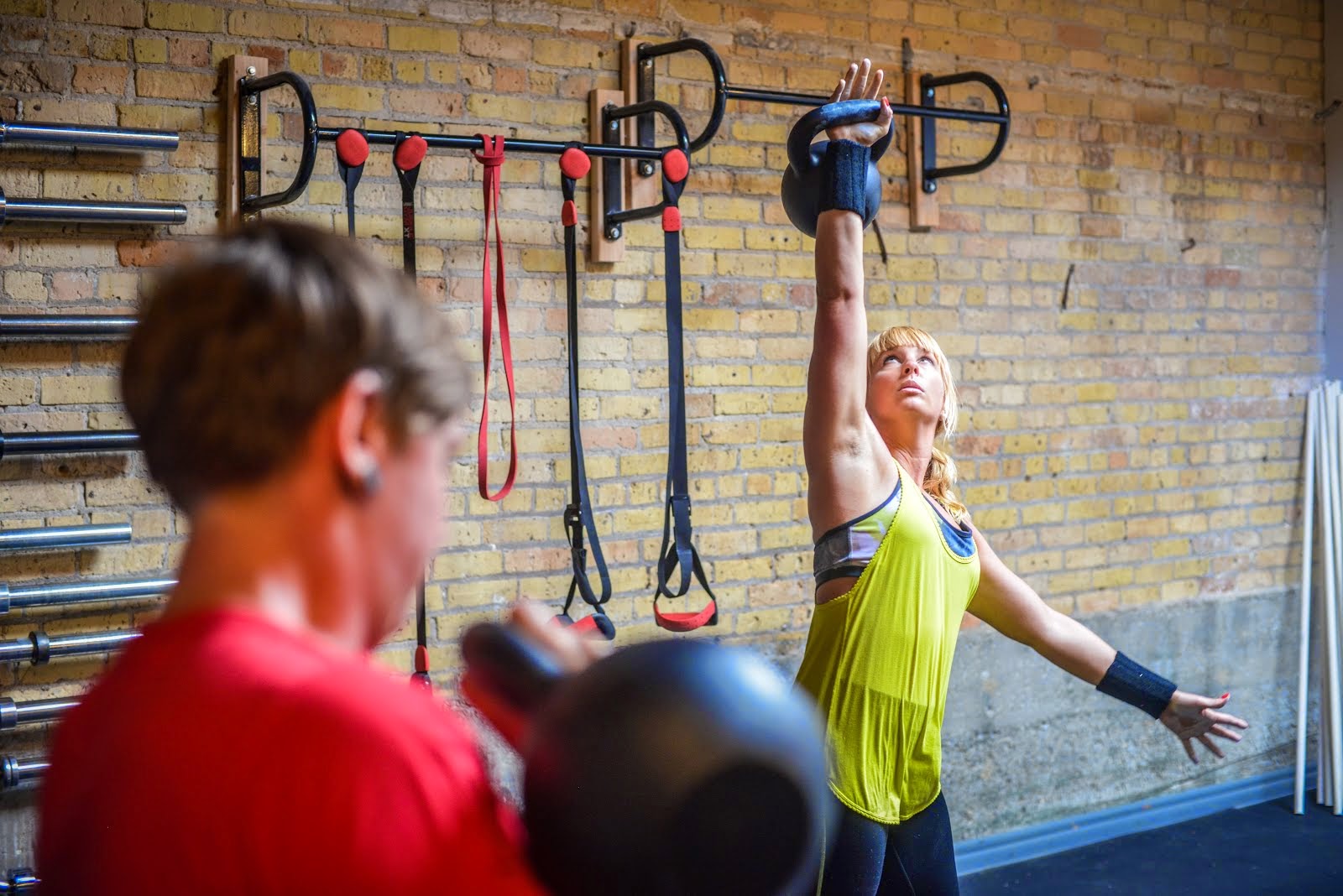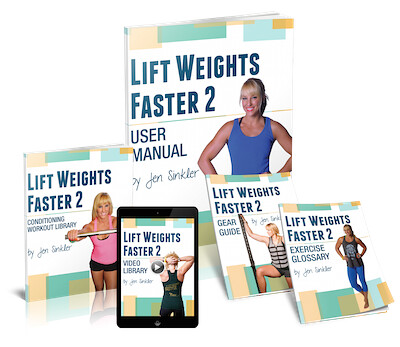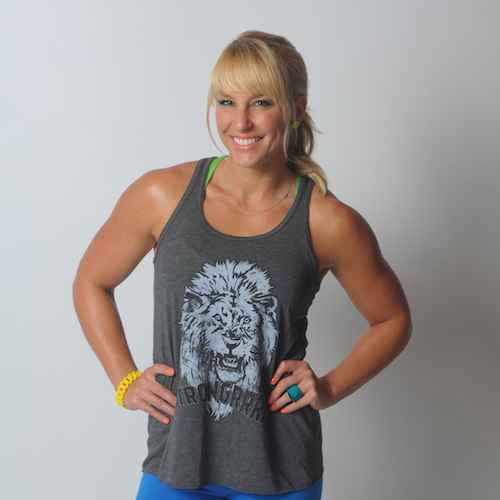Today I have a guest post from the one and only (and lovely), Jen Sinkler. It’s a timely post because 1) I’m in Australia and Lisa would kill me if I spent all my free time working and 2) Jen’s just released her updated Lifts Weights Faster 2.0.

I loved the first version when it came out last year; and to be speak candidly, outside of the athletes I train who need more specificity with their conditioning, when it comes to writing conditioning based programming (whether for myself or for my general fitness clientele) I tend to flip through LWF 1.0, find something the fits (10-30 minute workout), and sucktitude follows. But in a good way.
LWF 2.0 is 10x better and Jen has gone out of her way to provide an epic product that I feel is one of the best of its kind.
But that doesn’t come without a brief caution: OVER-conditioning. It’s a topic that Jen discusses below.
Lets Talk (Over) Conditioning
If you’re feeling pressure to make all your workouts the hardest, biggest, and most intense ever or else you’ll end up like this guy, you’re not alone. The go-hard-or-go-home mentality is pervasive, making many people fret worry that if they don’t do a body-crushing session every time they work out, they’ve failed.
In reality, the truth is nearly exactly the opposite. You can still make progress without destroying yourself. In fact, you can make bigger strides, more consistently and for the long term, when you don’t leave it all on the gym floor.
That doesn’t mean take it easy — it just means don’t run your body (and along with it your mind and spirit) into the ground by forcibly pushing past your limits every workout (maybe even any workout). You’ll find that this bod-friendly approach will net you even more positive results in the long run.
CHILL, HONEY BUNNY!
As a culture, we are obsessed with extremes. And maybe we don’t need to be. One of my fellow trainers at The Movement Minneapolis, “Cardigan Mark” Schneider, puts fitness on a spectrum — from ill to athlete.

From a marketing standpoint, the “athlete” end of the spectrum is sexy, but it can come at a high cost, in the form of overuse or acute injuries, chronic wear-and-tear on the body, and amount of time invested.
So let’s flip the script: What can you gain by easing off the gas slightly? Fewer injuries, less stress on the body, and a more sustainable fitness regimen — which is clutch, considering consistency is one of the keys to long-term success. Consider it a huge deposit in the bank for your future self; the you 10 years from now will be eternally grateful that you didn’t empty your account and push your body to the point of injury today.
Not always turning the dial up to 11 will also net you more time, money, and energy. If every workout has a cost, overdrawing our accounts means our bodies simply won’t function well — not ideal if your fitness goals include feeling better, moving better, and living better. A consistent, positive balance will better support your fitness goals.
KEEP IT SHORT AND SWEET
When we talk about conditioning, short, intense-enough sessions are the answer to keeping your account in the black and your fitness on track
A well-structured conditioning circuit will often move you out of the sagittal plane that many of the big movements (such as squats and deadlifts) in by asking you to rotate (or resist rotation), perform more unilateral movements, and crawl, roll, or jump.
You’ll involve different energy systems when you incorporate different levels of intensity by performing a variety of different movements with a spectrum of different tools and weight used. All of it adds up to more adaptation (i.e., progress), and more adaptation equals a stronger, fitter you.
CHECK YOURSELF BEFORE YOU WRECK YOURSELF
So…how do you keep your intensity in check? Easy — monitor how you’re feeling during the circuit.
When a conditioning circuit calls for five rounds, you don’t want to flame out after round three. Don’t push to failure on the repetitions and, if need be, take a longer rest than what is assigned in the workout. In the end, you’ll likely up the number of quality reps performed — and reap the gains from your hard (hard-enough) work — without having to deplete your account to do so.
.jpg)
One last thing! When deciding how hard to workout, consider the sum total of your stress.
Your body can’t differentiate between workout stress and other stress. So if you’re experiencing a lot of heart-rate-raising, cortisol-spiking events in your daily life, take the opportunity to chill and scale back your workouts for a while.
When life quiets down, your workouts can ramp up again. You do the math on who makes more progress: The person who goes hard for 52 minutes or the person who works within their limits for 52 weeks?
READY FOR BETTER RESULTS…FASTER?
If you’re looking to amp up your conditioning in creative and productive ways, I’ve put together a mammoth 181-workout pick-and-choose library called Lift Weights Faster 2.

Complete with a full exercise glossary that includes written descriptions and photographic demonstrations of nearly 270 exercises (from classic moves to more unusual ones — the Jefferson deadlift, anyone?), a video library that includes coaching on 30 of the more technical lifts, 10 challenge-workout videos, plus a dynamic warm-up routine, I’ve combined my training and athletic experience with my long background in magazine publishing to create a clear-cut, easy-to-use resource that you’ll want to turn to all the time.
Every workout is organized by the equipment you have available and how much time you’ve got, with options that last anywhere from five up to 30 minutes.
Lastly, I’d be remiss if I didn’t mention I teamed up with my husband, David Dellanave, to create a strength program companion resource called Get Stronger Faster 2 to help you take your strength level to the next level. This completes the total workout package and helps you get results, faster.
Click below for more information.
Lift Weights Faster 2.0
Jen Sinkler is a longtime fitness writer for national magazines such as Women’s Health and Men’s Health. A former member of the U.S. national women’s rugby team, she currently trains clients at The Movement Minneapolis. Jen talks fitness, food, happy life and general health topics at her website, www.jensinkler.com.








